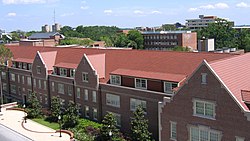
The University of Florida Campus Historic District is a historic district on the campus of the University of Florida in Gainesville, Florida. The district, bounded by West University Avenue, Southwest 13th Street, Stadium Road and Gale Lemerand Drive, encompasses approximately 650 acres (2.6 km2) and contains 11 listed buildings plus contributing properties. On April 20, 1989, it was added to the National Register of Historic Places. On June 24, 2008, additional information was approved which resulted in the addition of 6 contributing properties
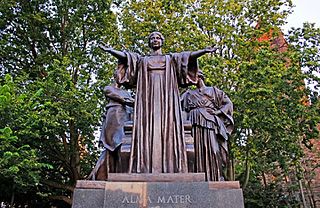
The Main Quadrangle at the University of Illinois at Urbana–Champaign comprises the main campus of the university. It is a major quadrangle surrounded by buildings of the College of Liberal Arts and Sciences (LAS) and is the center of campus activities.

Anderson Hall is a historic building located in the northeastern section of the University of Florida campus in Gainesville, Florida. The building houses the university's political science and religion departments, both a part of the College of Liberal Arts and Sciences. Anderson Hall was designed by William Augustus Edwards, responsible for planning nearly all of the campus' early buildings, in Collegiate Gothic style. Construction began in 1912, and the building opened in October 1913 as Language Hall.
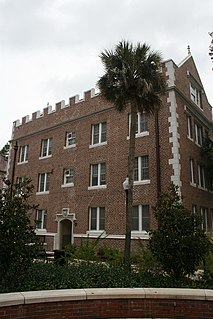
Buckman Hall is a historic building located in Murphree Area on the University of Florida campus in Gainesville, Florida, United States. It was designed by architect William A. Edwards in the Collegiate Gothic style and opened in 1906 as one of the two original buildings on the University of Florida's Gainesville campus. It once was a multi-purpose facility, but has been used exclusively as a student dormitory since the 1940s.
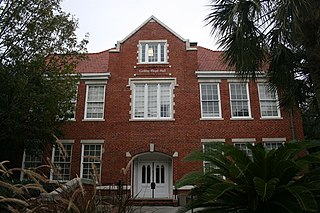
Griffin–Floyd Hall is a historic academic building located on the northeastern portion of the University of Florida campus in Gainesville, Florida. On June 27, 1979, it was added to the U.S. National Register of Historic Places. It currently houses the Department of Philosophy and Department of Statistics.

Thomas Hall, built in 1905, is a historic building located in Murphree Area on the campus of the University of Florida in Gainesville, Florida, United States. The building is named for William Reuben Thomas, the Gainesville mayor and businessman responsible for bringing the University of Florida to Gainesville.

Rolfs Hall is an historic building on the campus of the University of Florida in Gainesville, Florida, United States. It is located in the northeastern section of the campus. It was designed in the Collegiate Gothic style by William Augustus Edwards and completed by Rudolph Weaver, who succeeded him as architect for the Florida Board of Control. On September 11, 1986, it was added to the U.S. National Register of Historic Places. Rolfs Hall is named for Peter Henry Rolfs, who was dean of the College of Agriculture from 1915 to 1920.
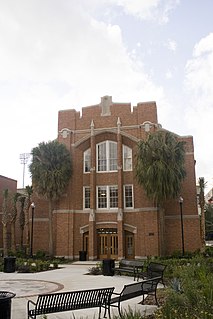
Kathryn Chicone Ustler Hall is a historic building on the campus of the University of Florida in Gainesville, Florida. It was designed by William Augustus Edwards in the Collegiate Gothic style and opened in 1919. As the University Gymnasium, it was the home to several of the university's indoor sports teams until the Florida Gymnasium opened in the late 1940s. The university became co-educational at about the same time, and the building was rechristened the Women's Gymnasium to be used primarily by the school's many new female students. On June 27, 1979, it was added to the U.S. National Register of Historic Places.

Norman Hall is an historic academic building on the eastern campus of the University of Florida in Gainesville, Florida. It was designed by architect Rudolph Weaver in the Collegiate Gothic style, and built in 1932. It originally housed the university's research and development primary and secondary schools, but now is the principal building of the university's College of Education. It is located on U.S. 441, near the southwest corner of S.W. 3rd Avenue and S.W. 12th Street in Gainesville. On January 26, 1990, it was added to the U.S. National Register of Historic Places.
Murphree Area is an historic residence hall complex on the northern edge of the University of Florida campus in Gainesville, Florida. The complex is adjacent to University Avenue, one of the major public roads that serve the university and define its boundaries. It was the university's first residence area and the last one to become co-ed. The Murphree Area complex is named for Albert A. Murphree, the second president of the university, who served from 1909 to 1927. It consists of the following five residence buildings, all built between 1905 and 1939:

The University of Minnesota Old Campus Historic District is a National Historic District located in Minneapolis, Minnesota. Listed in the National Register of Historic Places since 1984, it includes a number of historic buildings that were constructed during the late 1800s and early 1900s. The district represents the oldest extant section of the University of Minnesota campus.

The Plaza of the Americas is a major center of student activity on the campus of the University of Florida in Gainesville, Florida. It is located in the quad between Library West, Peabody Hall, the University Auditorium, and the Chemistry Building.

Walker Hall, originally known as the Mechanical Engineering Building, is an historic classroom building on the campus of the University of Florida in Gainesville, Florida, in the United States. It was designed by Rudolph Weaver in the Collegiate Gothic style and was built in 1927 It was later named for Col. Edgar S. Walker, a civil engineering professor.

Rudolph Weaver was an American architect, university professor and administrator renowned for various buildings that he designed in Florida, Idaho and Washington, many of which are academic.

The Hub, formerly known as the UF Bookstore, is a historic building on Stadium Road between Buckman Drive and Fletcher Drive on the University of Florida campus in Gainesville, Florida in the United States. On June 24, 2008, it was added to the National Register of Historic Places.

The Yulee area is a historic residence hall complex at 13th Street and Inner Road, SW, on the University of Florida campus in Gainesville, Florida in the United States. It is the site of the first permanent dormitories built for women after the campus became co-educational in 1947. On June 24, 2008, it was added to the National Register of Historic Places.

The William G. Carleton Auditorium, built in 1954, is a historic building on the campus of the University of Florida in Gainesville, Florida, in the United States. Like several other buildings on campus, it was designed by architect Guy Fulton in an early campus Brutalist style, and it is joined to Walker Hall by a breezeway. It seats 680 and was used as a lecture hall for the University College. In 1970, it was renamed for William G. Carleton, longtime professor of history and social sciences known for the colorful presentation of his freshman "American Institutions" lectures.

Matherly Hall built in the early 1950s is an historic classroom and faculty office building on the campus of the University of Florida in Gainesville, Florida, in the United States. It was designed by Guy Fulton in a modified Collegiate Gothic style to house the College of Business Administration. It is named for Walter Jeffries Matherly, dean of the business college from 1926 to 1954.

The history of the University of Florida is firmly tied to the history of public education in the state of Florida. The University of Florida originated as several distinct institutions that were consolidated to create a single state-supported university by the Buckman Act of 1905. The earliest of these was the East Florida Seminary, one of two seminaries of higher learning established by the Florida Legislature. The East Florida Seminary opened in 1853, becoming the first state-supported institution of higher learning in the state of Florida; the University of Florida traces its founding date to that year.
